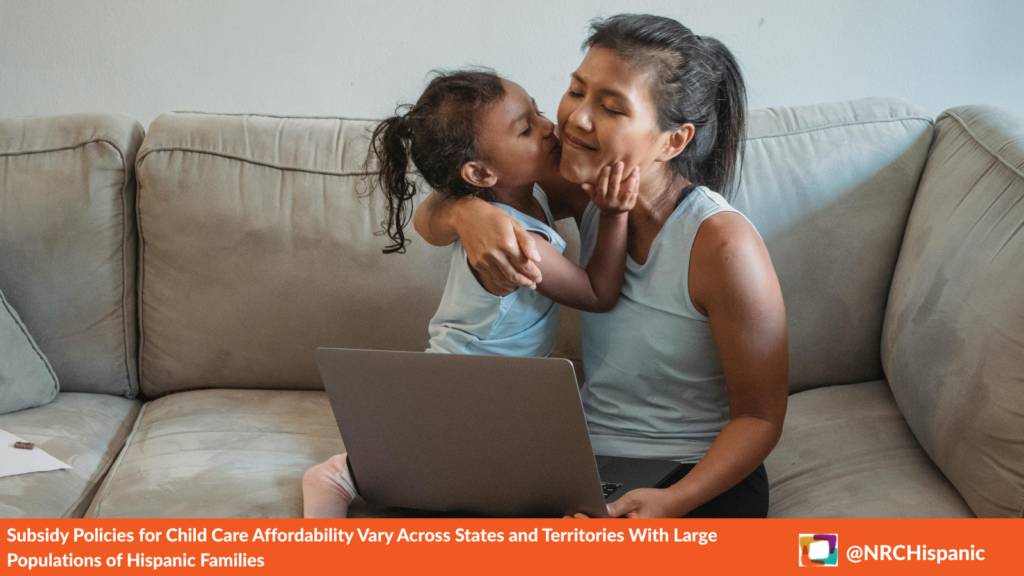Nov 8, 2017
Research Publication
How Common Are Nonstandard Work Schedules Among Low-Income Hispanic Parents of Young Children?
Authors:
Overview
As the United States has shifted to a 24/7 economy, increasing numbers of U.S. workers work nonstandard hours (i.e., beyond the traditional Monday to Friday daytime schedule).1 Given that early care and education (ECE) options are limited during these hours, nonstandard work schedules may make it difficult for families to secure and maintain regular ECE arrangements.2 These challenges are most acute for parents in the low-wage workforce who have fewer resources and often less control over the amount and timing of their work hours. Nonstandard schedules, especially those with unpredictable hours and limited worker input, also reduce the likelihood that eligible parents will access and maintain child care subsidies—a key public investment strategy for supporting low-income working parents with young children.3
Recognition of the potential mismatch between low-income parents’ employment demands and the parameters of ECE programs intended to serve them has prompted new policy efforts to expand access to ECE for those with nonstandard work schedules. For example, the 2014 reauthorization of the Child Care Development Fund (CCDF) includes a provision encouraging states to increase the supply and quality of care services available during nontraditional hours.
However, significant gaps persist in what is known about low-income Hispanic parents’ work lives and how they relate to ECE access and utilization. Hispanic parents and immigrant workers are over- represented in the low-wage workforce, where nonstandard schedules are commonplace,4 but recent national data indicate that most ECE providers who serve a high proportion of Hispanic children do not offer full-time or nonstandard hours.5 The limited availability of ECE options during nonstandard hours, especially for developmentally oriented programs like public pre-K and Head Start, raises important questions about how low-income Hispanic parents’ work schedules influence their ability to take advantage of the publicly funded early education opportunities targeted toward their children.
This brief draws on survey and retrospective calendar data from the 2012 National Survey of Early Care and Education (NSECE) to describe the work schedules of low-income Hispanic parents with young children from birth to age 5 (not yet in kindergarten), and provide comparison data for their non-Hispanic white and black counterparts.a We calculate the percentages of low-income Hispanic children with parents working standard weekday, early morning, evening, overnight, and/or weekend hours. We also examine the percentage of children whose parents have short advance notice (one week or less) of their work hours, which has been shown to complicate parents’ efforts to arrange child care and maintain family routines.6
Importantly, we report estimates separately for children in single- and two-parent households, as families’ ECE needs, preferences, and options vary depending on the number of parents in the home.b We additionally look at differences among Hispanic children by household nativity status.
Key Findings
Parental work during nonstandard hours is a common experience for young children in low-income households. Nationally, Hispanic children experience parental work schedules similar to their white and black peers, with a majority of working parents reporting early morning, evening, and/or weekend hours as part of their schedule. Many low-income parents also receive short advance notice of their work hours—particularly common in immigrant Hispanic households. Such nonstandard work schedules can pose challenges for establishing and maintaining family routines and for accessing early childhood care and education.
Key findings include:
- More than 3 in 4 Hispanic children whose parents reported work activity in the past week have a parent who worked during nonstandard times. Most of these parents also reported some work during standard weekday times.
- Early morning (5–8 am), evening (6 pm–12 am), and weekend parental work hours are a relatively common experience for low-income Hispanic children, affecting one-third to two-thirds of those with working parents, depending on the type of hours and whether the child lives with one or both parents.
- On the other hand, overnight parental work hours (12–5 am) are a relatively rare experience for low- income Hispanic children, affecting less than 5 percent of children with working parents in single-parent households, and less than 10 percent in two-parent households.
- There are few group race/ethnic differences in the timing of parents’ work activities.
- In single-parent homes, Hispanic children are more likely than their black peers to have a parent working weekend hours.
- In two-parent homes, Hispanic children are less likely than their white and black peers to have a parent working evening hours, and less likely than black peers to have a parent working overnight hours.
- Half of Hispanic children in low-income households have a parent who receives short advance notice of their work hours (i.e., one week or less); this is higher than for some other groups.
- In single-parent homes, Hispanic children are more likely to have a parent with short advance notice of work hours than their black peers.
- In two-parent homes, Hispanic children are more likely to have a parent with short advance notice of work hours than their white peers.
- Hispanic children in immigrant and nonimmigrant households have similar parental work schedules, with two exceptions. First, Hispanic children in two- parent immigrant households are more likely than their peers in U.S.-born households to have a parent who works weekend hours. Second, Hispanic children in immigrant households are more likely than those in U.S.-born households to have a parent who receives short advance notice of their work hours (roughly 60 percent and 40 percent, respectively).
Findings
The prevalence of standard and nonstandard parental work hours
Our first analysis estimates the percentage of all young children in low-income households who have parents engaged in work activities (including work, job training, and adult education) during standard hours only, nonstandard hours only, or some combination of standard and nonstandard hours. We present these estimates by race/ethnicity and family structure.
As shown in Figure 1 and Table 1, the most common parental work schedule experienced by the full sample of young children in low-income households (across race/ ethnicity and family structure) involves a combination of standard and nonstandard hours.
Among Hispanic children living with one parent, approximately 10 percent have a parent who works standard, weekday times exclusively; less than 5 percent have a parent who works nonstandard hours only; and 30 percent have a parent who works both standard and nonstandard hours. An additional 55 percent did not have a parent with work hours in the past week.c Similar percentages were observed for white and black children living with one parent, with the exception that black children are more likely than their Hispanic counterparts to have a parent who works standard hours only (20 percent versus 11 percent, respectively).
For children living with two parents, the percentage with at least one parent working in the past week is higher than for those living with a single parent; however, the distribution of work schedule types is similar and we find no significant group differences by race/ethnicity. Approximately 10 percent of Hispanic children (and their white and black peers) in two-parent homes have a parent working standard hours only; less than 5 percent have a parent working nonstandard hours only; and approximately 70 percent have a parent who works some combination of standard and nonstandard hours.
When the analysis is limited to children whose parents reported any work activity in the prior week, it becomes even more evident that nonstandard parental work hours are the norm, rather than the exception, for young children with low-income working parents. Table 2 shows that, among Hispanic children with parental work activity, 75 percent in single-parent homes and 87 percent in two-parent homes had a parent working nonstandard hours.

Types of nonstandard hours included in parents’ work schedules
The remainder of this brief focuses on the sample of children whose parents reported work activity in the prior week to estimate the percentage of children whose parents worked during four types of nonstandard times: early morning, evening, overnight, and weekend hours.
First, we find that early morning work hours (between 5 am and 8 am) are relatively common in low-income households with young children (Figure 2). Among those with working parents, 29 percent of Hispanic children in one-parent homes and 64 percent in two-parent homes have a parent who works early morning hours. Included in the latter estimate is the small percentage (8 percent) of children for whom both parents report early morning hours as part of their schedule. There are no statistically significant race/ethnic differences in these percentages.

Evening parental work hours (6 pm–12 am) are also common, experienced by roughly 2 of 5 Hispanic children with low-income working parents (Figure 3). In one-parent homes, the percentage of Hispanic children with a parent who works in the evening (40 percent) is comparable to their white and black peers. In two-parent homes, Hispanic children are somewhat less likely than white and black children to have a parent who works evening hours (38 percent versus 44 and 46 percent, respectively); fewer than 5 percent of Hispanic children have both parents working evening hours.

Very few Hispanic children have parents who work overnight hours (12 am–5 am), as shown in Figure 4. Among those with working parents, only 4 percent of Hispanic children living with one parent and 7 percent of those living with two parents have a parent who works these hours (2 percent of whom have two parents working overnight hours). In general, overnight parental work hours are also uncommon for white and black children in low-income households. However, in two-parent homes, black children are more likely to have parents who work overnight hours than Hispanic children (25 versus 7 percent).

Weekend parental work hours are experienced by approximately 45 percent of Hispanic children with low-income working parents (Figure 5). In one-parent homes, this percentage is similar to that for white children (40 percent), but higher than for black children (23 percent). In two-parent homes, the prevalence of parental work on the weekend is similar for Hispanic, white, and black children (approximately 45 percent).

Short advance notice of work hours
The NSECE household survey asks how far in advance parents know their work hours for a particular week. Longer advance notice is helpful to parents and allows them to plan for child care and organize family life more generally; on the other hand, short notice may interrupt family routines and leave parents scrambling to arrange care.
Hispanic children’s parents, in particular, are likely to receive short advance notice of their work hours, defined here as one week or less in advance.
In one-parent homes with reported work activity, 49 percent of Hispanic children had a parent who received short notice of work hours, more than comparable figures for black (34 percent) and—marginally—for white (36 percent) children.
In two-parent homes with work activity, 43 percent of Hispanic children have one parent who received short advance notice of their work hours, and 12 percent have two parents with this type of schedule (for a total of 55 percent). These rates are higher than those for white children (32 percent and 3 percent, for a total of 35 percent), but similar to figures for black children (41 percent and 7 percent, for a total of 48 percent).

Do work schedule characteristics vary significantly by Hispanic household nativity status?d
Although we find that the prevalence of early morning, evening, and overnight parental work hours is similar for Hispanic children in immigrant and non-immigrant households with working parents (results not shown), significant differences emerged for weekend hours and advance notice of work schedule.
Hispanic children in immigrant households are more likely to have a parent who works weekend hours than their counterparts in non-immigrant households (although the difference is statistically significant only for children living with two parents) (Figure 7).
Consistent with the suggestion in the literature that immigrant workers often have less predictable work hours than their non-immigrant counterparts, we find that Hispanic children in immigrant households are more likely than those in non-immigrant households to have parents who receive short advance notice of their work schedule (Figure 8). This characteristic can be particularly challenging for securing and maintaining ECE arrangements, and applies to more than half of Hispanic children in low-income immigrant households with working parents.

Discussion
Parental nonstandard work hours—during the weekend, evening, and early morning—are a common experience for young Hispanic children in low-income households, as they are for their non-Hispanic white and black peers. Among those with working parents, 75 percent of Hispanic children in single-parent homes and nearly 90 percent of those in two-parent homes experience at least some nonstandard parental work hours. Most parents in these households do not work standard or nonstandard hours exclusively, but rather some combination of both.
These results have potential implications for Hispanic children’s participation in ECE, especially in publicly funded programs focused on child enrichment (e.g., Head Start/Early Head Start, public pre-K). These programs primarily target children in low-income families and generally operate during traditional weekday hours, often in the morning. Our findings suggest, however, that parental work is rarely limited to these hours. Parents who work nonstandard hours may still enroll children in these programs, but the schedule mismatch may require extra time and resources to arrange transportation and/or additional child care arrangements to cover work hours. Public ECE programs can help meet families’ needs by offering wrap-around care options that allow for early drop-off and late pick-up; however, weekend work hours are more difficult for most formal programs to accommodate. Instead, informal arrangements with family, friends, and neighbors may address this gap, or some parents may use weekend work hours to trade off care with a parent who works during the week.
Recent national child care provider data from the NSECE study highlights potential gaps between the schedules of ECE providers and low-income working Hispanic parents. Centers that serve a high proportion of Hispanic children are less likely than those serving a low proportion to offer full-time weekday care (47 and 58 percent, respectively). Full-time hours are more likely to be offered by homebased providers. This analysis also indicates that few providers, regardless of type of program or proportion of Hispanic children served, offer weekend and evening hours.7
Overnight work hours were the least common type of nonstandard schedule reported, affecting less than 5 percent of Hispanic children in single-parent homes and less than 10 percent in two-parent homes. Parents of young children may avoid nighttime hours whenever possible given the lack of care options during this time; concerns about overnight care, especially with strangers; and/or the strain that these work hours can impose on personal and family well-being.8
We examined parental work schedule characteristics separately by family structure given potentially different constraints, resources, and strategies across one- and two-parent households. Two-parent families may have more flexibility to divide or trade off employment and child care responsibilities. Approximately one-third of Hispanic children in two-parent homes have only one parent engaged in work activity, while two-thirds have two working parents. We find that most low-income Hispanic dual-earner couples with young children do not work the same types of nonstandard hours. For example, fewer than 5 percent of Hispanic children in two-parent homes experience both parents working evening hours. This may be an intentional decision by families to maximize parental care—especially during nonstandard times, which tend to be more closely associated with home and family life.
The predictability of parents’ schedules from week to week also has implications for children’s care. We find that roughly half of all Hispanic children with working parents have a parent who receives short advance notice (1 week or less) of their work hours, which is likely to complicate ECE utilization given that ECE programs typically require children to attend on a regular schedule. These parents may use informal arrangements because they tend to offer more flexibility in terms of variable hours and charging only for actual hours of care provided. Notably, this work characteristic occurs more often in immigrant Hispanic households than in U.S.-born Hispanic households. Recent analyses of child care supply data in the NSECE indicate that more than one-third of providers serving a large proportion of Hispanic children allow for variable hours and adjust charges accordingly, which can accommodate parents with unpredictable or fluctuating hours. However, this flexibility is more likely to be available with homebased providers than from center-based programs.9
Hispanic children in immigrant, two-parent households are more likely to have a parent who works weekend hours than their counterparts in non-immigrant households. Additionally, children in immigrant households are more likely to have a parent with short advance notice of their work hours. Immigrant Hispanic parents may be more likely to hold the types of jobs that require weekend work and/or have variable schedules; this may be especially true for those with limited English or documentation status concerns (although we do not explore this association here). However, higher rates of weekend work might also reflect families’ decisions about how to organize work and child care demands. Weekend work hours by one parent may allow the other parent (or another adult in the household) to work weekdays and trade off care for children. If immigrant families have a stronger preference to keep young children in parental care and/or have fewer available ECE options than non-immigrant families, they may seek out this type of work schedule when possible.
Interestingly, the prevalence of early morning, evening, and overnight parental work hours is similar for Hispanic children in immigrant and non-immigrant households. However, it is possible that the implications of these types of work hours for parents’ ECE searches and decision-making may differ by household nativity.
Although we do not explore this possibility here, affordable, high-quality ECE options that match families’ schedules may be less accessible to families who are recent arrivals to the United States, have limited English skills, and/or have concerns related to a household member’s documentation status. At the same time, a recent analysis of administrative data from Chicago shows higher rates of participation in publicly funded ECE programs for Hispanic children in Spanish-speaking and immigrant households, relative to their Hispanic peers in households without these characteristics, suggesting that local context may matter.10
This descriptive brief contributes to the sparse literature on the work lives of low-income Hispanic parents raising young children. The findings indicate that, as with many of their peers in low-income white and black households, Hispanic children are exposed to parental work schedules that include hours beyond the standard weekday. A companion brief using the NSECE calendar data on children’s schedules finds that 2 of every 3 Hispanic children in ECE arrangements experience time in care during nonstandard times, and that care provided during nonstandard hours is associated with less use of center-based arrangements.11 A potential next step in this work is to use data like the NSECE to more directly link parents’ work schedule characteristics to children’s child care schedules, examining associations between certain types of hours and ECE search difficulties, utilization patterns, and missed work because of child care problems.
Our findings also highlight the need for more in-depth research on the processes by which Hispanic parents negotiate and coordinate work schedules and children’s care, to better understand the accommodations and trade-offs that are made. More information is also needed on how decisions related to employment and ECE are made within the larger context of household needs and resources, including the presence of other adults and older children. For example, although this analysis focused on the work schedules of each child’s parents, more than one-quarter of low-income Hispanic children also have a nonparental adult in their household.12 Complex household structures may increase the number of individuals available to care for children, but also increase the number of schedules that must be coordinated.
Finally, additional research is needed to track how the changing ECE landscape is meeting the needs of low-income Hispanic families. One of the stated goals of the 2014 reauthorization of the Child Care Development Fund is to promote more flexible ECE options for low-income families by increasing the supply and quality of care available during nontraditional times; however, states have significant latitude around when and how they implement this objective. One recent analysis suggests that state-level child care policies and administrative practices may interact with demographic characteristics in ways that differentially affect Hispanic families and contribute to racial/ethnic disparities in CCDF utilization.13


Notes
a In this analysis, child race/ethnicity is based on information provided by the household survey respondent. Children are classified as Hispanic/Latino if this was provided as a response to the question about ethnicity or the question about race. The white and black child race categories do not include children who were identified as multi-racial.
b Other nonparental adults in the household may serve important roles in the economic and child care needs of the household; however, we focus these analyses on the work characteristics and schedule of children’s parents—in part because parents are typically children’s main caregivers and their work schedules likely shape parental time, family routines, and the organization of family life.
c As noted in the Definitions box, our measure captures work activity in the week prior to the survey and not rates of employment, which may be higher.
d In this analysis, a household with at least one adult who was foreign-born was identified as an immigrant household. A household in which all adults were born in the United States was identified as a U.S.-born household.
About This Series
This brief is part of an ongoing series aimed at better understanding the intersection of work and family dynamics for Hispanic households, with particular attention to children’s early care and education experiences. This brief uses data from the National Survey of Early Care and Education (NSECE)—a set of four integrated, nationally representative surveys that describe the ECE landscape in the United States. Related briefs in this series include:
References
1. Presser, H. & Ward, B.W. (2011). Nonstandard work schedules over the life course: A first look. Monthly Labor Review, 134, 3–16.
Enchautegui, M. (2013). Nonstandard Work Schedules and the Well-Being of Low-Income Families. Washington, DC: Urban Institute.
2. Henly, J.R. & Lambert, S. (2005). Nonstandard work and child-care needs of low-income parents. Chapter 30 in Bianchi, S.M., Casper, L.M., & King, R.B. (Eds.), Work, Family, Health, and Well-Being, 473–492. Lawrence Erlbaum Associates, Inc.
Zaslow, M., Crosby, D.A., & Smith, N. (2013). Issues of quality and access emerging from the changing early childhood policy context: Toward the next generation of research. In E.T. Gershoff, R.S. Mistry, & D.A. Crosby (Eds.), Societal Contexts of Child Development: Pathways of Influence and Implications for Policy and Practice. New York, NY: Oxford University Press.
3. Henly, J.R., Sandstrom, H., Claessens, A., Ros Pilarz, A., & Gelatt, J. (2015). Determinants of Subsidy Stability and Child Care Continuity: Final Report for the Illinois–New York Child Care Research Partnership. Washington, DC: Urban Institute.
Rachidi, A. (2015). Child Care Assistance in the United States and Nonstandard Work Schedules. Washington, DC: American Enterprise Institute.
Henly, J.R., Kim, J., Sandstrom, H., Pilarz, A., & Claessens, A. (2017). What explains short spells on child care subsidies? Social Service Review, 91(3), 488-533.
Henly, J.R., Sandstrom, H., & Pilarz, A (2017). Child care assistance as work-family support: Meeting the economic and caregiving needs of low-income working families in the US. Chapter 11 in M. las Heras, N. Chinchilla, & M. Grau (Eds.), Work-Family Balance in Light of Globalization and Technology, pgs. 241–262. Newcastle: Cambridge Scholars Publishing.
4. Kalleberg, A.L., Reskin, B.F. & Hudson, K. (2000). Bad jobs in America: Standard and nonstandard employment relations and job quality in the United States. American Sociological Review, 256–278.
Capps, R., Fix, M. & Lin, S.Y. (2010). Still an hourglass? Immigrant workers in middle-skilled jobs. Migration Policy Institute. http://www.migrationpolicy.org/research/immigrant-workers-middle-skilled-jobs-0.
Earle, A., Joshi, P., Geronimo, K., & Acevedo-Garcia, D. (2014). Job characteristics among working parents: Differences by race, ethnicity, and nativity. Monthly Labor Review, U.S. Bureau of Labor Statistics. https://doi.org/10.21916/ mlr.2014.19.
5. Guzman, L., Hickman, S., Turner, K., & Gennetian, L. (2017). How well are early care and education providers who serve Hispanic children doing on access and availability? Bethesda, MD: National Research Center on Hispanic Children & Families. https://hispanicrescen.wpengine.com/research-resources/how-well-are-early-care-and-education-providers-who-serve-hispanic-children-doing-on-access-and-availability/
6. Henly, J. R. & Lambert, S. (2014). Unpredictable work timing in retail jobs: Implications for employee work-life outcomes. Industrial and Labor Relations Review, 67(3), 986–1016.
Henly, J. R., Shaefer, H.L., & Waxman, R.E. (2006). Nonstandard work schedules: Employer- and employee-driven exibility in retail jobs. Social Service Review, 80, 609–634.
7. Guzman et al. (2017).
8. Grzywacz, J.G., Daniel, S.S., Tucker, J., Walls, J., & Leerkes, E. (2011). Nonstandard work schedules and developmentally generative parenting practices: An application of propensity score techniques. Family Relations, 60(1), 45–59.
Hsueh, J. & Yoshikawa, H. (2007). Working nonstandard schedules and variable shifts in low-income families: Associations with parental psychological well-being, family functioning, and child well-being. Developmental Psychology,43(3), 620–632.
Liu, H., Wang, Q., Keesler, V., & Schneider, B. (2011). Non-standard work schedules, work-family conflict and parental well-being: A comparison of married and cohabitating unions. Social Science Research, 40, 473–484.
9. Guzman et al. (2017).
10. Lopez, M., Grindal, T., Zanoni, V. & Goerge, R. (2017). Hispanic Children’s Participation in Early Care and Education: A Look at Utilization Patterns of Chicago’s Publicly Funded Programs. Bethesda, MD: The National Center for Research on Hispanic Families & Children. https://hispanicrescen.wpengine.com/research-resources/hispanic-childrens-participation-in-early-care-and-education-a-look-at-utilization-patterns-of-chicagos-publicly-funded-programs/
11. Crosby, D.A. & Mendez, J.L. (2016). Hispanic Children’s Participation in Early Care and Education: Amount and Timing of Hours by Household Nativity Status, Race/Ethnicity, and Child Age. Bethesda, MD: The National Center for Research on Hispanic Families & Children. https://hispanicrescen.wpengine.com/research-resources/hispanic-childrens-participation-in-early-care-and-education-amount-and-timing-of-hours-by-household-nativity-status-race-ethnicity-and-child-age/
12. Turner, K., Guzman, L., Wildsmith, L. & Scott, M. (2015). The Complex and Varied Households of Low-Income Hispanic Children. Bethesda, MD: The National Center for Research on Hispanic Families & Children. https://hispanicrescen.wpengine.com/research-resources/the-complex-and-varied-households-of-low-income-hispanic-children/
13. Hill, Z., Gennetian, L. Mendez, J.L., Crosby, D. & Guzman, L. (2017). Do state CCDF policy guidelines differentially affect Hispanic families’ access and utilization? A seven state scan. Presentation delivered as a symposium at the Child Care and Early Education Policy Research Consortium (CCEEPRC) Annual Meeting, Washington, DC, March 2, 2017.




